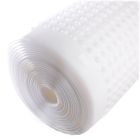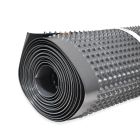Help & Advice Articles, Videos and How-to-Guides
Filter Articles

Waterproofing Vaulted Ceilings: How to Guide
When it comes to waterproofing vaulted ceilings, there are some additional considerations when compared to a standard ceiling. This is true of both above and below ground scenarios. Permagard stocks a wide range of membranes, systems and accessories suitable for vaulted ceilings and arches.
From wine cellars to playrooms, untapped storage space to commercial offices, vaulted spaces are a real asset. And it’s time to maximise them. However, with an increased risk of flooding for many areas, you need to protect these spaces with appropriate waterproofing systems.
In this guide we take you through how to achieve safe and dry vaulted spaces above and below ground, protecting against water ingress.
What are vaulted ceilings?
Vaulted ceilings is a term used to refer to several different and unique types of ceiling. What they have in common is a self-supporting arch that exists above the walls. The different styles of vault include barrel, arched, groin, rib and fan.
More often vaulted spaces are an historical feature, often in properties built in the eighteenth and nineteenth centuries. Some contemporary designs incorporate vaulted ceilings or arches to bring softness to a space, but these tend to be above ground and not at direct risk from water ingress.
Waterproofing Above Ground Vaulted Ceilings / Vaults
If you have arched vaults that aren’t part of a cellar or basement (but are subterranean spaces as they were built on the original ground level) or railway arches above ground, then you want to provide protection against water ingress. The recommended waterproofing system is the same as if you were waterproofing a vaulted cellar or basement, that is entirely below ground. We will cover the full methodology below.
Waterproofing Below Ground Vaults / Vaulted Ceilings
Vaulted ceilings were a popular feature in many 18th and 19th century buildings. They are more common in certain areas of the UK such as Bristol, Bath, Harrogate as well as historic areas of London. Basically, in any town or city where Georgian and Victorian architecture is more common, you are likely to find vaults. Unfortunately, many of these vaults now suffer from water ingress and in turn damp issues.
Remember – if you need your goods quickly, Permagard’s trade counter is just off the M5, conveniently located for much of the South West – especially Bath and Bristol.
Preparing your vault for waterproofing
When waterproofing a vault, you begin with prepping the slab - this may be installing a new slab or preparing the old slab. This makes sure that you have a suitable slab in which to install your sump and drainage channels. Once the slab is prepared, you can move onto the membrane installation.
It is important that your walls and vaulted ceiling are sound and clean. This means removing any loose debris, filling any holes and defects with Fillet Seal.
Some installers may want to add a cementitious tanking before applying the Type C drained system. This isn’t strictly necessary, but can be beneficial if there is a substantial risk of water ingress.
Installing a cavity drainage system in a vault / on a vaulted ceiling
We recommend PermaSEAL 8 clear membranes or PermaSEAL 8 ECO Recycled membrane for waterproofing vaults. At Permagard, we advise against using a mesh membrane for vault ceilings due to the number of additional fixings required and the additional weight of wet plaster or renders.
You want to install your first PermaSEAL clear membrane along the central line of the vault, end to end. It’s important to over cut it by at least 400mm so the membrane travels down onto the end wall. This is so you can cut into it later and joint it with the wall membrane.
Run plugs end to end to secure the first membrane in place. Fixings should be at 400mm centres. It’s essential that you use PermaSEAL rope around the membrane plugs to ensure you achieve a seal. Plugs with grommets do not allow you to get the required seal when dealing with a vaulted space.
Jointing membranes on a vaulted ceiling
When it comes to jointing subsequent sections of membrane on the vault, opt for a roof tile approach so that there is no chance of water getting anywhere near the joints. You want a 3 to 6 stud overlap on the underside of the previous fixed membrane.
We recommend using a fleece overstrip / corner strip between the wall and vault. This provides a high-performance waterproof seal as well as a good key for a plaster or render finish.
Finishing off on a vaulted ceiling / vault
We recommend batten and board or other dry-lining methods as they are lighter and easier to apply and finish than wet renders and plaster. You should batten on the plug line to take your plasterboard. You may want to consider using two layers of plasterboard as this helps create a smoother and more stable structure. You may also want to consider insulation too.
Installing Floor membranes for a vault
Once you’ve installed the vault and wall membrane you then need to focus on installing the drainage channel followed by the floor membrane.
PermaSEAL drainage channels should be installed around the perimeter of the space as well as across the floor to lead into a sump chamber fitted with appropriate pumps. This Type C system ensures that any water coming into the vault is safely channelled and pumped away.
At this stage, with the sump pump correctly installed and set-up, you can then lay the floor membrane.
You can read full details on Cavity Drainage System installation and Sump Pump set-up in our guides.
Permagard - Vault Waterproofing Experts
Permagard has excellent stock availability across our range of cavity drain basement waterproofing products. We stock everything you need to install a Type C waterproofing system in a vaulted space. Our experts are happy to advise you further on how to install it within a vault either above or below ground.
We offer delivery within one to three days. But if you’re looking for cavity drain waterproofing supplies near you, we have a depot just off the M5 where you can click and collect from our trade counter within just an hour.
If you need advice about installing type C cavity waterproofing systems, our technical advisers are here to help. Simply call us on 0117 982 3282.


